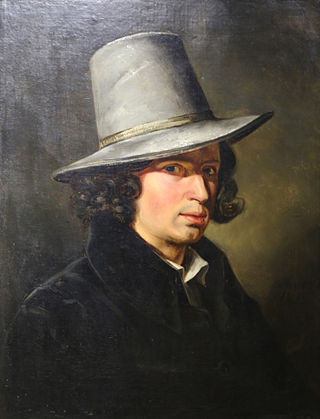

Christoph Hawich (17 September 1782, Trier - 5 September 1848, Trier) was a German lithographer, drawing teacher and porcelain painter. His name is also given as "Hahvich", "Havig", and "Habich".


Christoph Hawich (17 September 1782, Trier - 5 September 1848, Trier) was a German lithographer, drawing teacher and porcelain painter. His name is also given as "Hahvich", "Havig", and "Habich".
He came from a family of painters that emigrated to Trier from Koblenz in mid-eighteenth century. His first artistic training came from his father, Stephan Hawich , and a local painter named Jungblut. A letter of application to be a drawing teacher mentions additional study in Düsseldorf, but there is no independent evidence of this. [1]
He was initially employed as a drawing teacher at several private schools, and briefly operated his own. In 1816, he obtained a position at the Trier porcelain manufactory, which had been acquired by a family friend when the area passed from French to Prussian rule. In addition to painting the porcelain, he was in charge of the manufactory's drawing school. He created many of his own designs, but also used those provided by other artists. Due to company policy, he was unable to sign his name to them. Most of the designs were of local landscapes and Roman-era monuments.
In 1822, he was able to find a permanent position as a drawing teacher at the new Knabenbürgerschule (Boys' School). He remained there until 1846, when he was forced to retire, due to age related issues. [2] He also gave private lessons to working people until 1830, when they were no longer profitable, due to changes in working hours that effectively limited him to Sundays.
In 1823, he became the first lithographer in Trier; helped by a loan from the city government and some individual patrons. [3] That same year, he issued a large portfolio with views of Trier and explanatory text, written by Theodor von Haupt . Many of the images were adapted from his porcelains. From 1824 to 1826, he created another series devoted to the history, notable personalities and topography of Trier. Most of the original images were provided by Johann Hugo Wyttenbach, founder and manager of the Municipal Library . The text was written by Dr. Johann Mathias Neurohr (1777-1841), an amateur archaeologist. His business closed in 1827, due to slow sales.
Both of his marriages, to Margarete Becker from Eschdorf (1810) and Elisabeth Molitor from Trier (1838), remained childless.

Johann Baptist Homann was a German geographer and cartographer, who also made maps of the Americas.

Johann Heinrich Bleuler, the Elder was a Swiss artist who worked with porcelain, landscape sketches and gouache. He was also an art teacher and a publisher of engravings.
The Düsseldorf School of painting is a term referring to a group of painters who taught or studied at the Düsseldorf Academy roughly between 1819 and 1918, first directed by the painter Wilhelm von Schadow.

Georg Melchior Kraus was a German painter. He was a co-founder of the Weimar Princely Free Drawing School, together with Friedrich Justin Bertuch, in 1776.

The Royal Porcelain Factory in Berlin, also known as the Royal Porcelain Manufactory Berlin and whose products are generally called Berlin porcelain, was founded in 1763 by King Frederick II of Prussia. Its actual origins, however, lie in three private enterprises which, under crown patronage, were trying to establish the production of "white gold" in Berlin from the mid-18th century onwards.

Johann Eleazar Zeissig, also known as Schenau, was a German genre, portrait and porcelain painter, and engraver; director of the Royal Academy of Arts in Dresden.

Carolus Magnus Hutschenreuther was a German industrialist and the founder of the C.M. Hutschenreuther Porcelain Factory in Hohenberg an der Eger, Bavaria.

Tragheim Church was a Protestant church in the Tragheim quarter of Königsberg, Germany.

Ludwig Lange was a German architect and landscape designer.

Johann Anton Alban Ramboux was a German painter and lithographer.
Andreas Borum was a German painter and lithographer who also worked in stone, and a collector.

Franz Xaver Friedrich Quant, known as Fritz was a German painter, graphic artist and designer.

Wilhelmine Halberstadt was a German educator and author.

Moïse Jacobber, born Jacob Ber was a German-born French painter who worked at the Manufacture nationale de Sèvres. He specialized in painting flowers.

Johann Friedrich Steinkopf was a German landscape, animal and porcelain painter.

Christian Wilhelm Richard Kampf was a German architect in the Historic style.

Simon Meister was a German painter.

Feodor Iwanowitsch Kalmyk, also known as Kalmyk, was a Kalmyk painter and engraver. He called himself Feodor Ivannoff, and that is how he is listed in the Karlsruhe address books. He also signed his will under that name.

Johann Heinrich Schilbach was a German landscape painter.

Ena Rottenberg was a Hungarian-Austrian craftswoman, draftswoman, ceramist and member of the artists' community of the Wiener Werkstätte.